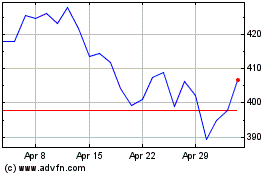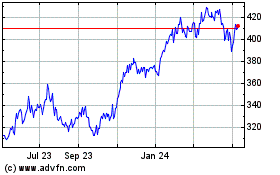Microsoft's Rural Broadband Solution: TV 'White Space'
July 11 2017 - 12:30AM
Dow Jones News
By Jay Greene
Microsoft Corp. plans to put its lobbying and financial muscle
behind a long-shot technology that taps unused television bandwidth
to bring broadband access to underserved areas of America.
In a speech Tuesday in Washington, Microsoft president and chief
legal officer Brad Smith is expected to announce support for
so-called TV white-space technology, which the company says is a
frugal way to address the digital divide between U.S. cities and
rural areas.
He also plans to encourage the Trump administration and Congress
to ensure white-space spectrum is available on an unlicensed basis
in every market in the country, and to consider the technology as
they develop a new national infrastructure proposal.
The Federal Communications Commission estimates more than 23
million people in rural areas lack "fast" internet access, defined
as having minimum download speed of 25 megabits a second. Cities
commonly have service speeds that top 100 MB a second.
Microsoft, which has advocated white-space technology for years,
said it will form partnerships with rural telecommunications
companies to invest in at least 12 projects in 12 states over the
next year, hoping to bring broadband connectivity to two million
people in rural America by July 4, 2022.
The company declined to say how much it will spend on the
effort. Mr. Smith in an interview referred to the spending as a
"civic investment," but acknowledged bringing high-speed
connectivity to rural areas will likely bring new customers to the
software giant as well.
"It's going to be good for everybody in technology, including
Microsoft, " Mr. Smith said.
The technology Microsoft is championing harnesses unused
bandwidth between TV channels to wirelessly deliver access. To use
that spectrum, telecoms set up base-station radios, which can send
and receive signals up to 10 miles in rural areas. Those radios
transmit to antennas attached to homes, which connect to Wi-Fi
routers inside.
The promise is that TV white space could provide access to the
distant reaches of the country at a fraction of the cost of other
options. Microsoft estimates it would cost $10 billion to $15
billion to connect rural America with broadband access using TV
white spaces, compared with $15 billion to $25 billion using fixed
wireless technology, and $45 billion to $65 billion running
fiber-optic cable to homes.
The broadcast industry doesn't share Microsoft's support. In a
letter to the FCC on Monday, National Association of Broadcasters
associate general counsel Patrick McFadden said there are only 800
white-space devices registered in the U.S. -- many just test
devices.
"Microsoft has been making promises about white spaces
technology for well over a decade," he wrote. "Yet there remain few
tangible consumer benefits associated with white spaces deployments
across the U.S."
The trade group is concerned that the spectrum Microsoft hopes
telecom partners will use for white-space services could interfere
with broadcast TV channels. Moreover, broadcasters have complained
they don't have enough spectrum of their own.
In response to the broadcast group's criticism, Microsoft noted
"most new telecommunication technologies have taken over a decade"
from the regulatory authorization to commercial adoption. "TV White
Spaces have been no exception," a company spokesman said.
While the technology hasn't taken off in the U.S., Microsoft has
financially backed white-space efforts to bring internet access to
185,000 people in 20 projects globally, including rollouts in
developing countries such as Kenya, Colombia and the
Philippines.
Microsoft is betting it can catalyze the market in the U.S. now,
in part, because the technology is improved and a business model
has been established abroad. It plans to help rural telecoms cover
capital expenses and take a share of revenue generated to recoup
its costs.
Microsoft already has doled out $250,000 to Mid-Atlantic
Broadband Communities Corp., said Tad Deriso, chief executive of
the southern Virginia telecom. With another $500,000 from the
Virginia Tobacco Region Revitalization Commission and $250,000 of
its own money, Mid-Atlantic Broadband plans to bring white-space
service to 1,000 customers by year-end.
The service, which residents acquire through local schools,
provides free internet access to a limited number of
education-related sites at speeds of about 3 to 4 MB a second.
Customers can access the entire web at the same speed for $10 a
month, or pay $40 a month for service that hits 8 to 10 MB a
second, though that falls below the FCC's definition of "fast."
About 90% of homes have opted for the free service, Mr. Deriso
said.
The money from Microsoft and others is crucial because the cost
of deploying the technology is about $1,000 a home, Mr. Deriso
said. "Eventually, we'd like to see it be $100," he said.
Write to Jay Greene at Jay.Greene@wsj.com
(END) Dow Jones Newswires
July 11, 2017 00:15 ET (04:15 GMT)
Copyright (c) 2017 Dow Jones & Company, Inc.
Microsoft (NASDAQ:MSFT)
Historical Stock Chart
From Mar 2024 to Apr 2024

Microsoft (NASDAQ:MSFT)
Historical Stock Chart
From Apr 2023 to Apr 2024
